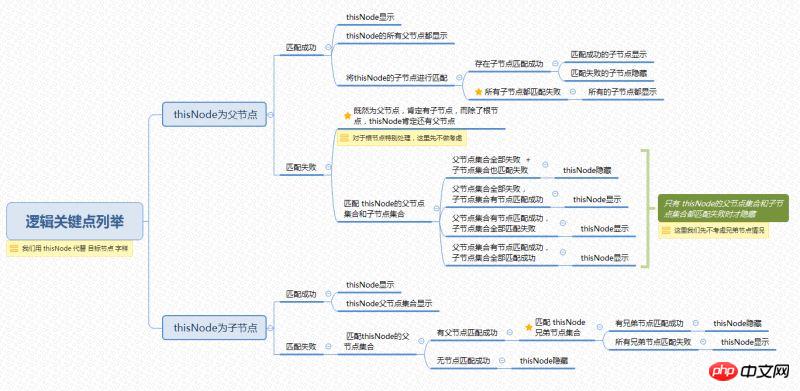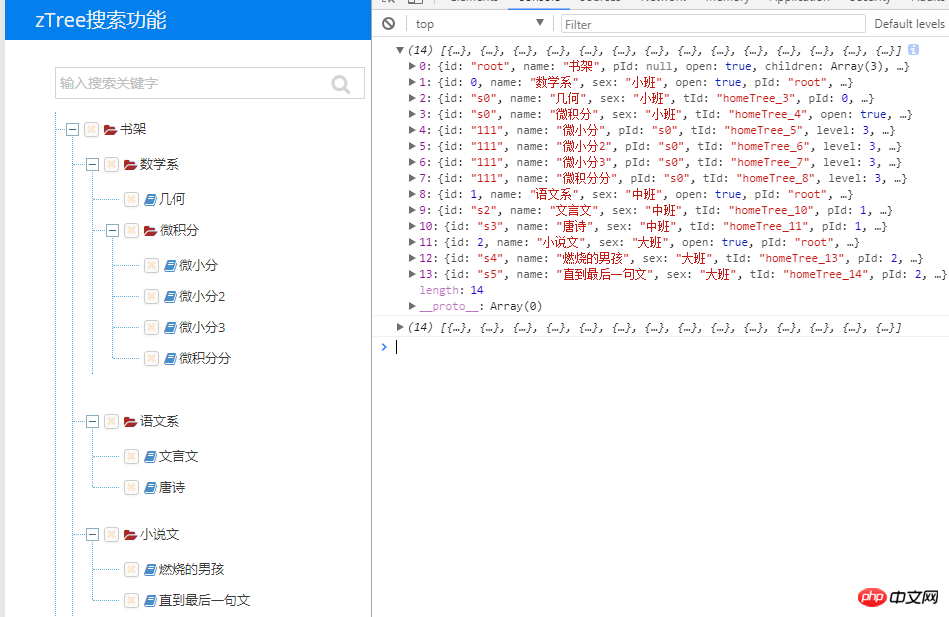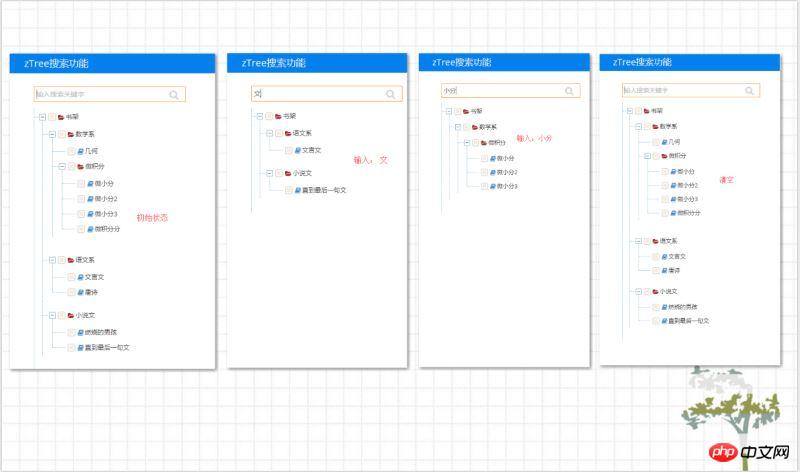jQuery implements recursive infinite layer function
This time I will bring you jQuery to implement the recursive infinite layer function. What are the precautions for jQuery to implement the recursive infinite layer function? The following is a practical case, let's take a look.
Nagging
Two days ago, a friend told me that he wanted a ztree search function, and I slapped him in the face: This kind of Are there too many methods that countless predecessors have failed to do? I went to find it myself, I was very busy~ Then I squatted silently and wrote the zTree search method. why? Because I said, "It's impossible to find it. Many people must have done it countless times. If you can't find it, I'll write it to you and ask you to have lunch." However, I searched for a long time and couldn't find it ( Tears, my plan, my lunch~). Most of them use getNodesByParamFuzzy() or highlighting in the API. However, friends said that the requirements are not met: 1. If the matching fails, the parent node is also hidden; 2. The matching rules can be customized, that is, it can match names and attributes... (Anyway, what I want is not spicy, Xiaosheng With a smile on my face, but in my heart...then I will write it for you~), enter the text below:
Mind Map

The general search function only matches keywords within the "established range (convenient name)". The "established range" means that we already know the search range: for example, a text library, a drop-down box , in other words, the size of our matching object set has been determined. However, this is not feasible on ztree. Why? When I thought about the implementation logic of the ztree search function, I asked: So, is the level of this tree fixed? Or are you not sure how many layers there are? The old man looked at me and smiled knowingly: You write in infinite layers~ Xiaosheng’s calf twitched. . Because the level of the tree is uncertain, the search range is uncertain. For example: the target node is matched successfully. If this node is a child node, then its parent node should also be displayed, and then the parent node of its parent node should also be Displayed, and then the parent node of its parent node's parent node... Orz... It seems that it will never end... There is no other way but to: recurse to find all the parent nodes and child nodes of the target node.
Key points of logic
In the above mind map, I roughly listed the logic, under what circumstances the target node is displayed, and what This is a key point that we must be clear about. Let’s take a closer look at the existence of the target node: The development of the search function has been clearly understood in the mind. The only thing left is the implementation method. However, this is not a problem at all~ (Xiaosheng secretly thinks that what is really worrying is that the process of the function is not clear. As for the implementation method, you all know it. Right? 0.0..)
 ##About tree nodes
##About tree nodes
var treeObj=$.fn.zTree.getZTreeObj("homeTree"); // 设置根节点
var node = treeObj.getNodes(); // 获取根节点
var nodes = treeObj.transformToArray(node); // 获取所有节点
console.log(nodes);Look at the picture again: we can see various attributes of any node, including the child node set we want, the parent node attribute isParent, the node id tId, the parent node id parentTid...
 Everything is ready, get started
Everything is ready, get started
Let’s take a look at the relevant methods. Many small details need to be discovered during the actual coding process. For the convenience of display, they are listed here. method.
Declare the backup array: 
// 地区搜索 var parentArray = []; var childArray = [];
// 递归获取目标节点所有父节点
function getParentsNode(treeNode){
var thisParentNode = treeNode.getParentNode(); //得到该节点的父节点
if( thisParentNode != null ){ // 父节点存在
parentArray.push(thisParentNode); // 储存至数组
getParentsNode(thisParentNode); // 重调
}else{
return false;
}
} // 递归获取目标节点所有子节点
function getChildrenNode(treeNode){
var thisIsParent = treeNode.isParent; // 获取目标节点 isParent 属性,判断是否为父节点
if( thisIsParent == true ){
var thisChildrenNode = treeNode.children; // 得到该节点的子节点集合
for(var i=0;i<thisChildrenNode.length;i++){
childArray.push(thisChildrenNode[i]); // 将该子节点加入数组中
getChildrenNode(thisChildrenNode[i]); // 重调
}
}else{
return false;
}
} //匹配节点
function matchNode(treeNode,num){
var inputArea = $("input[name='searchArea']");
var name = treeNode.name;
var entityCode = treeNode.entity_code|| '';
var val = inputArea.val(); // 获取检索值
var numName = name.indexOf(val);
var numCode = entityCode.indexOf(val);
var num = -1;
if( numName != -1 || numCode !=-1 ){
num = 1;
}
if( numName == -1 && numCode == -1 ){
num = -1;
}
return num;
}节点匹配成功方法:
// 节点匹配成功
function checkTrueArray(arr,treeNode){
var thisTid = treeNode.tId;
var thisLi = $("#"+thisTid);
for(var n=0;n<arr.length;n++){
var thisNodeId = arr[n].tId;
var thisNodeLi = $("#"+thisNodeId);
thisLi.show();
thisNodeLi.show();
}
}节点匹配失败方法:
// 节点匹配失败
function checkFalseArray(arr,treeNode){
var result = [];
var result2 = [];
var thisTid = treeNode.tId;
var thisLi = $("#"+thisTid);
var val = inputArea.val(); // 获取检索值
var thisParent = treeNode.getParentNode(); // 获取目标节点父节点
if( thisParent != null ){ // 有父节点
var thisBrotherArr = treeNode.getParentNode().children; // 得到包含自身的兄弟数组
for(var m=0;m<arr.length;m++){ // 匹配父节点
var num = matchNode(arr[m]);
if( num != -1 ){
result.push(arr[m]);
}
}
var resultLength = result.length;
for( var m=0;m<thisBrotherArr.length;m++ ){ // 匹配兄弟节点
var num = matchNode(thisBrotherArr[m]);
if( num != -1 ){
result2.push(thisBrotherArr[m]);
}
}
var resultLength2 = result2.length;
// 对于自身匹配失败的节点,要显示必须满足有父节点匹配成功,且兄弟级节点都匹配失败
if( (resultLength == 0 && resultLength2 == 0) || resultLength2 != 0 ){
thisLi.hide();
}
if( resultLength !=0 && resultLength2 == 0 ){
thisLi.show();
}
}else{
thisLi.hide();
}
}目标节点匹配失败 目标节点即有父节点又有子节点:
// 目标节点匹配失败 目标节点即有父节点又有子节点
function checkAllArray(arr,arr2,treeNode){
var result = [];
var result2 = [];
var thisTid = treeNode.tId;
var thisLi = $("#"+thisTid);
var val = inputArea.val(); // 获取检索值
for(var m=0;m<arr.length;m++){ // 匹配子节点或父节点
var num = matchNode(arr[m]);
if( num != -1 ){
result.push(arr[m]); // 匹配成功储存至数组
}
}
var resultLength = result.length; // 获取匹配成功后返回的数组长度
for(var m=0;m<arr2.length;m++){ // 匹配子节点或父节点
var num = matchNode(arr2[m]);
if( num != -1 ){
result2.push(arr2[m]); // 匹配成功储存至数组
}
}
var resultLength2 = result2.length; // 获取匹配成功后返回的数组长度
if( resultLength == 0 && resultLength2 == 0 ){ // 子节点和父节点都匹配失败
thisLi.hide();
}else{
thisLi.show(); // 有一种匹配成功或都匹配成功
}
}定义搜索方法:
function searchArea(treeId, treeNode){ // 定义搜索方法
var inputArea = $("input[name='searchArea']");
var val = inputArea.val(); // 获取检索值
var treeObj=$.fn.zTree.getZTreeObj("homeTree"); // 设置根节点
var node = treeObj.getNodes(); // 获取根节点
var nodes = treeObj.transformToArray(node); // 获取所有节点
console.log(nodes);
for(var i=0;iCopy after login 调用搜索方法:
// 调用搜索方法
$(".searchAreaBtn").click(function(treeId, treeNode){
searchArea(treeId, treeNode);
});
var inputArea = $("input[name='searchArea']");
inputArea.keyup(function(treeId, treeNode,e){
var e = event || window.event;
var val = inputArea.val();
if( e.keyCode == 13 || val == "" ){
searchArea(treeId, treeNode);
}
});看效果(电脑ps出问题了,用美图秀秀拼的图~囧...):

结语
理论上来说应该是能支持无限层的,最多试了四层,没有问题,没有做更多测试,有兴趣的看官可以试试,需要demo的可以留言,互相学习,一起进步,么么哒~
相信看了本文案例你已经掌握了方法,更多精彩请关注php中文网其它相关文章!
推荐阅读:
The above is the detailed content of jQuery implements recursive infinite layer function. For more information, please follow other related articles on the PHP Chinese website!

Hot AI Tools

Undresser.AI Undress
AI-powered app for creating realistic nude photos

AI Clothes Remover
Online AI tool for removing clothes from photos.

Undress AI Tool
Undress images for free

Clothoff.io
AI clothes remover

Video Face Swap
Swap faces in any video effortlessly with our completely free AI face swap tool!

Hot Article

Hot Tools

Notepad++7.3.1
Easy-to-use and free code editor

SublimeText3 Chinese version
Chinese version, very easy to use

Zend Studio 13.0.1
Powerful PHP integrated development environment

Dreamweaver CS6
Visual web development tools

SublimeText3 Mac version
God-level code editing software (SublimeText3)

Hot Topics
 1653
1653
 14
14
 1413
1413
 52
52
 1305
1305
 25
25
 1251
1251
 29
29
 1224
1224
 24
24
 What functions does Doubao app have?
Mar 01, 2024 pm 10:04 PM
What functions does Doubao app have?
Mar 01, 2024 pm 10:04 PM
There will be many AI creation functions in the Doubao app, so what functions does the Doubao app have? Users can use this software to create paintings, chat with AI, generate articles for users, help everyone search for songs, etc. This function introduction of the Doubao app can tell you the specific operation method. The specific content is below, so take a look! What functions does the Doubao app have? Answer: You can draw, chat, write articles, and find songs. Function introduction: 1. Question query: You can use AI to find answers to questions faster, and you can ask any kind of questions. 2. Picture generation: AI can be used to create different pictures for everyone. You only need to tell everyone the general requirements. 3. AI chat: can create an AI that can chat for users,
 The difference between vivox100s and x100: performance comparison and function analysis
Mar 23, 2024 pm 10:27 PM
The difference between vivox100s and x100: performance comparison and function analysis
Mar 23, 2024 pm 10:27 PM
Both vivox100s and x100 mobile phones are representative models in vivo's mobile phone product line. They respectively represent vivo's high-end technology level in different time periods. Therefore, the two mobile phones have certain differences in design, performance and functions. This article will conduct a detailed comparison between these two mobile phones in terms of performance comparison and function analysis to help consumers better choose the mobile phone that suits them. First, let’s look at the performance comparison between vivox100s and x100. vivox100s is equipped with the latest
 What exactly is self-media? What are its main features and functions?
Mar 21, 2024 pm 08:21 PM
What exactly is self-media? What are its main features and functions?
Mar 21, 2024 pm 08:21 PM
With the rapid development of the Internet, the concept of self-media has become deeply rooted in people's hearts. So, what exactly is self-media? What are its main features and functions? Next, we will explore these issues one by one. 1. What exactly is self-media? We-media, as the name suggests, means you are the media. It refers to an information carrier through which individuals or teams can independently create, edit, publish and disseminate content through the Internet platform. Different from traditional media, such as newspapers, television, radio, etc., self-media is more interactive and personalized, allowing everyone to become a producer and disseminator of information. 2. What are the main features and functions of self-media? 1. Low threshold: The rise of self-media has lowered the threshold for entering the media industry. Cumbersome equipment and professional teams are no longer needed.
 What are the functions of Xiaohongshu account management software? How to operate a Xiaohongshu account?
Mar 21, 2024 pm 04:16 PM
What are the functions of Xiaohongshu account management software? How to operate a Xiaohongshu account?
Mar 21, 2024 pm 04:16 PM
As Xiaohongshu becomes popular among young people, more and more people are beginning to use this platform to share various aspects of their experiences and life insights. How to effectively manage multiple Xiaohongshu accounts has become a key issue. In this article, we will discuss some of the features of Xiaohongshu account management software and explore how to better manage your Xiaohongshu account. As social media grows, many people find themselves needing to manage multiple social accounts. This is also a challenge for Xiaohongshu users. Some Xiaohongshu account management software can help users manage multiple accounts more easily, including automatic content publishing, scheduled publishing, data analysis and other functions. Through these tools, users can manage their accounts more efficiently and increase their account exposure and attention. In addition, Xiaohongshu account management software has
 PHP Tips: Quickly Implement Return to Previous Page Function
Mar 09, 2024 am 08:21 AM
PHP Tips: Quickly Implement Return to Previous Page Function
Mar 09, 2024 am 08:21 AM
PHP Tips: Quickly implement the function of returning to the previous page. In web development, we often encounter the need to implement the function of returning to the previous page. Such operations can improve the user experience and make it easier for users to navigate between web pages. In PHP, we can achieve this function through some simple code. This article will introduce how to quickly implement the function of returning to the previous page and provide specific PHP code examples. In PHP, we can use $_SERVER['HTTP_REFERER'] to get the URL of the previous page
 What is Discuz? Definition and function introduction of Discuz
Mar 03, 2024 am 10:33 AM
What is Discuz? Definition and function introduction of Discuz
Mar 03, 2024 am 10:33 AM
"Exploring Discuz: Definition, Functions and Code Examples" With the rapid development of the Internet, community forums have become an important platform for people to obtain information and exchange opinions. Among the many community forum systems, Discuz, as a well-known open source forum software in China, is favored by the majority of website developers and administrators. So, what is Discuz? What functions does it have, and how can it help our website? This article will introduce Discuz in detail and attach specific code examples to help readers learn more about it.
 Detailed explanation of the functions and functions of GDM under Linux
Mar 01, 2024 pm 04:18 PM
Detailed explanation of the functions and functions of GDM under Linux
Mar 01, 2024 pm 04:18 PM
Detailed explanation of the functions and functions of GDM under Linux In the Linux operating system, GDM (GNOMEDisplayManager) is a graphical login manager that provides an interface for users to log in and log out of the system. GDM is usually part of the GNOME desktop environment, but can be used by other desktop environments as well. The role of GDM is not only to provide a login interface, but also includes user session management, screen saver, automatic login and other functions. The functions of GDM mainly include the following aspects:
 What is PHP used for? Explore the role and functions of PHP
Mar 24, 2024 am 11:39 AM
What is PHP used for? Explore the role and functions of PHP
Mar 24, 2024 am 11:39 AM
PHP is a server-side scripting language widely used in web development. Its main function is to generate dynamic web content. When combined with HTML, it can create rich and colorful web pages. PHP is powerful. It can perform various database operations, file operations, form processing and other tasks, providing powerful interactivity and functionality for websites. In the following articles, we will further explore the role and functions of PHP, with detailed code examples. First, let’s take a look at a common use of PHP: dynamic web page generation: P




